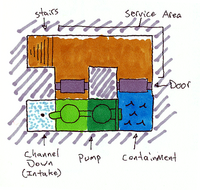- v50 information can now be added to pages in the main namespace. v0.47 information can still be found in the DF2014 namespace. See here for more details on the new versioning policy.
- Use this page to report any issues related to the migration.
v0.31:Obsidian farming
| Part of a number of articles on |
| Projects |
|---|
| Basic |
| Aqueduct • Archery tower • Atom smasher • Danger room • Dam • Garbage dump • Mass pit • Moat • Pit trap • Reservoir• Sally port • Swimming pool • Tower • Tree farm |
| Advanced |
| Drowning chamber • Magma piston • Obsidian farm • Pump stack • Silk farm • Water reactor |
| This article is about an older version of DF. |
Obsidian farming is a method of producing obsidian efficiently. When magma contacts water, a tile of unworked obsidian spawns on the meeting point and both fluids disappear (from that tile). Obsidian is a valuable stone and both magma and water are renewable.
A typical method of farming is as follows:
- A rectangle hall, 2 z-levels high is dug out/constructed
- Lower level of the hall is fed magma from a pump (otherwise it will fill very slowly)
- Upper level of the hall is covered in water (pump is a good idea too)
- Water gets removed (by a pump, opened floodgate etc.)
- Resulting obsidian (on the lower level) is designated for ramping or channeling (floor between levels needs to be removed for the farm to be reused)
For more advanced farms, one can have few layers of magma and water - each new layer adds another layer of obsidian, so this method is far more efficient (N - number of fluid layers, (N-1) - number of obsidian layers). Your dwarven ingenuity should be shouting "OBSIDIAN FORTRESS" by now, by the way.
Another, possibly simpler, design is 3 z-levels high:
- Uppermost level contains a water reservoir, the floor is channeled out and covered with a retracting bridge, to drop water when needed, and an access way to the plumbing may include a raising bridge; the combination of retracting and raising bridges will result in a measuring reservoir, which drops no more water than necessary. It may include an access stairway to the middle level, for maintenance purposes.
- Middle level is an access room; floor may be channeled out or ramped out from below, but it should not be there. It should include a connection to the fortress at large, and a drain to someplace else; it may be a pump which pumps water back to the water reservoir above, it might lead to the caverns or an aquifer. Outside the farm must be two levers; one controls the bridges in the water reservoir, one which controls the magma floodgate.
- Lower level is the magma reservoir; floor should be intact. Must have access to magma, controlled by floodgate. Again, may include access stairway to middle level.
Requirements: 6 mechanisms (8 if measuring reservoir is used), one of which must be magma-safe. 1 magma-safe floodgate 1 (2 is measuring reservoir is used) bridge(s) 3 z-levels you're willing to dedicate to an obsidian farm.
Operating instructions: 1. Open the floodgate and flood the magma reservoir. 2. Retract bridge and empty the water reservoir. 3. Wait until water is gone. 4. Remove obsidian using channels/ramps. Between 1 and 2, you can use the magma as a garbage disposal. Additionally, if you have a raising bridge at point P in the diagram above, the water reservoir becomes measuring; it will dispense no more water than should be necessary.
Try to avoid "free" magma tiles. Magma pump should pump directly into the hall, not into a tunnel leading to the hall. Results of doing otherwise include fun, fire and tantrums when the obsidian is being dug out, unless the tunnel itself is sealed (with a floodgate, for example) before collection of the precious black stone (actually volcanic glass). Same tip applies to water pumps in case of obsidian fortress, except this time the only danger is mud and annoying messages.
Note that if you add water to a tile which is as little as 1/7th full of magma, you'll create a full block of obsidian. This is particularly useful when you're operating a repeatable magma piston since one block of obsidian will displace 7/7 units of magma, and you'll only need 1-2 units of magma to make a block of obsidian to get 7 units of magma...
